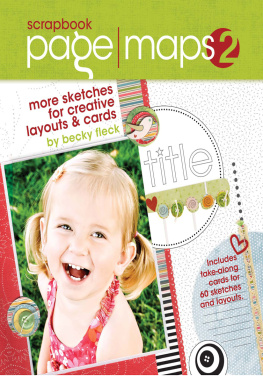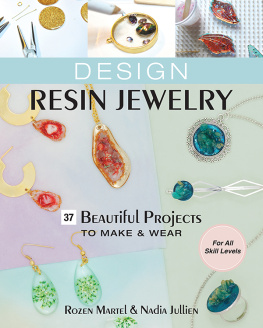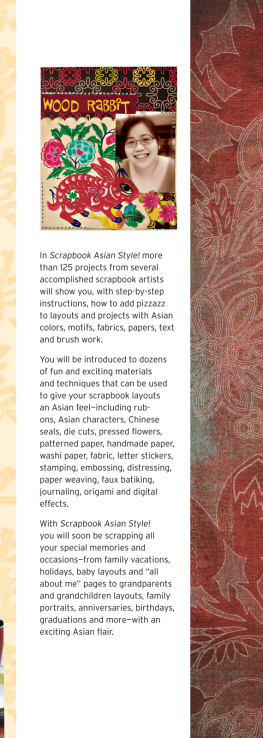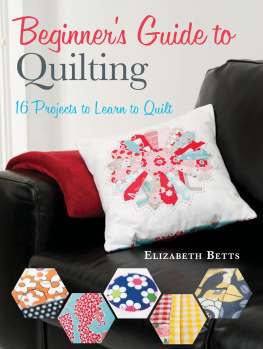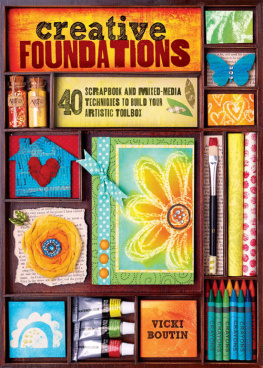Contents
Projects
Introduction
During a visit to Manhattan years ago, I found myself standing in line at a shop alongside a beautifully tattooed woman whose jacket was adorned with a pink satin prize ribbon rosette embellished by a brass snake centerpiece. It was as if shed been awarded Best in Show in a New York young artist pageant. I was immediately bit by the rosette bug.
A round, floral design, the rosette has been seen throughout history in many forms. In the eighteenth century, gentlemen pinned colorful ribbon cockades to their tri-cornered hats as a sign of political allegiance, and ladies wore rosettes of the finest silk as fashion accessories. Paper and ribbon rosettes substituted for flowers in winter months, in churches and homes. And since the nineteenth century, ruffled medallions with tailpieces have been offered as awards to celebrate momentous achievements and personal triumphs, such as for superior livestock and exceptional baked goods. More recently, crafters have taken hold of this timeless design by emulating trophy-shop awards or creating wearable rosette art.
Rosettes are constructed from single or multiple tiers of paper, ribbon, or other materials, graduating in size and finished with a centerpiece as a focal point. Materials for making your own rosettes can be found at your local craft and hardware stores. The possibilities are endless for creating unique custom rosettes as wearable accessories, home and studio dcor, and personalized gifts and awards.
In this booklet, Ive included fun and easy projects to inspire you to craft rosettes. In the following pages, Ive described the basic materials, tools, and techniques youll need for making rosettes. The colorful papers suggested in the portfolio will get you started, and can be used with other materials you have on hand. You might be surprised by just how far a small scrap of fabric or paper can go. Ive also given you a list of ideas for themes, materials, and centerpieces for crafting fabulous rosettes for every occasion. With all the creative ideas presented in this booklet, I hope youll be inspired to make many of your own unique rosette art pieces!
Materials & Tools
Many rosettes can be crafted using minimal tools and materials depending on the complexity and style of the project. With the suggested decorative papers, youll be off to a great start, creating beautiful rosettes in no time. Whats more, you may be able to substitute some tools for things you already have on hand, such as the top of a small crochet hook for the round tip stylus or the tip of a bone folder for scoring fold lines into your paper. And because crafting rosettes can take materials such as paper, textiles, and trinkets to new dimensions, its fun to experiment with items you might otherwise discard.
TEXTILES
Your favorite small-pattern or solid-color fabrics can be pressed with an iron into long strips, folded and ruffled or pleated, and manipulated into rosette tiers. You can use ribbons and trims of all shapes, textures, patterns, widths, and lengths for your rosettes. Even the smallest length of decorative ribbon or trim can be used to embellish your rosettes.
Printable cotton sheets are letter-size fabric pieces with a paper backing that can be run through a desktop printer. These are perfect for printing an image, like a photo, onto fabric or for printing a design, like the monogram and floral one used in the Embroidered Monogram ().
PAPERS & CARDSTOCK
Decorative papers for making rosettes can be anything from patterned scrapbook papers to the Sunday newspaper comics. Papers designed with small patterns create a more cohesive look to rosette tiers than papers with large patterns. Vintage papers that are thinner and more brittle can be reinforced by backing them with a sheet of letter-size sticky label stock before manipulating them into folds. Several kinds of patterned papers are described in this portfolio to get you started.
Various weights of plain cardstock are used for making gluing rounds, backing rounds, and backing pieces for rosette tiers.
THEMATIC & DECORATIVE OBJECTS
Trinkets and bobbles such as bingo game pieces, buttons, and birthday candles add a great deal of character to any rosette. Whether as repeat object tiers or as centerpieces, these accessories add a unique touch to your rosettes. Custom decorative objects can be crafted by using a shape punch to cut out graphics on greeting cards or other cardstock items, while small round picture frames are excellent for silhouette and photo rosette centerpieces. Objects as simple as a vintage milk-bottle cap or an inexpensive tomato pincushionstudded with colorful ball-head straight pinscan add fabulous dimension to finish off your rosette tiers.
CUTTING TOOLS
A sharp craft knife is excellent for trimming paper along a metal ruler, and is also a perfect tool for picking up tiny embellishments for gluing. A dull craft knife is useful for carefully taking apart existing button badges that you want to use as new rosette centerpieces.
Either a guillotine paper cutter or a rotary paper trimmer with a sliding blade makes precision cutting of paper fast and easy. Both are marked with measuring increments that can be very useful for many rosette projects.
A crafter needs both a dedicated pair of sharp scissors and pinking shears for fabric and a separate pair of sharp scissors and pinking shears for paper. Using the same scissors and shears for both fabric and paper will dull the blades.
A precision circle cutter effortlessly cuts out measured rounds of paper and cardstock, referred to as gluing rounds, used in many of the projects in this book, to which you attach ribbons and paper elements that make up the rosette tiers.
You can use decorative paper punches, specialty scissors, and decorative rotary cutters to create a decorative edge on the rosette paper elements. A paper punch that makes 1-in-/2.5-cm-diameter circles is perfect for creating small rosette centerpieces and repeat objects, and punches that make 2- to 3-in-/5- to 7.5-cm-diameter circles can take the place of a circle cutter. Decorative shape punches can be used for crafting multiple petal-like embellishments for rosette tiers. Small, round decorative paper punches create excellent centerpiece finishes to many accordion-fold paper rosettes. A standard hole punch can be used to create holes for hanging or tying rosettes from string or hooks.
Whether crafting wire hanging loops or manipulating dollar bills into rosettes using wire, a pair of wire cutters is essential to avoid damaging the blades of a good pair of scissors.
FOLDING TOOLS
Scoring your paper for folding, like some of the scored patterned papers in this kit, is essential for a successful rosette. A scoring board has a surface with grooves for debossing equally spaced straight fold lines into your paper as a guide for precise accordion folding. You can create a similar effect by lightly marking equal increments along both edges of your paper with a pencil, placing the strip onto a semisoft surface (a sheet of craft foam works well), and, using a straight-edge ruler and bone folder or round-tip stylus, carefully debossing your fold lines. Using a scoring board, however, will cut construction time and effort considerably, which is golden when crafting multiple rosettes.
A bone folder is a wonderful tool used to score paper, create sharp folds, and burnish surfaces. Resembling a tongue depressor with one pointed end, it is traditionally made from animal bone and used in bookbinding and origami, though todays bone folders are primarily made of synthetic material. Most scoring boards come complete with their own bone folder. A
Next page

